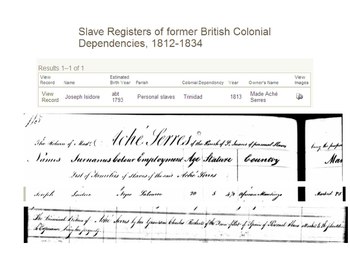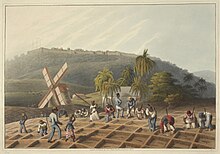British Caribbean Slave Register (1817-1834)
| British Caribbean slave registers | |
|---|---|
|
World document heritage |
|

|
|
| Slave labor harvesting a sugar cane plantation, Antigua 1823 |
|
| State (s): |
|
| Duration: | approx. 740 volumes and lists |
| Period: | 1817-1834 |
| Storage: | National archives of the individual states |
| Register link: | Registry of Slaves of the British Caribbean 1817-1834 |
| Admission: | 2009 ( session 9 ) |
The slave registers from the British Caribbean , created for the years 1817 to 1834 , have been a joint UNESCO World Document Heritage of the Bahamas , Belize , Dominica , Jamaica , St. Kitts , Trinidad and Tobago and the United Kingdom since 2009 . They were expanded to include a contribution from Bermuda in 2011 .
Creation of the registers
In 1807 Great Britain banned the transatlantic slave trade , with which Africans were brought as slaves into the British possessions in the West Indies. The slave trade between the colonies remained legal until 1811. The abolitionists demanded a complete census of the slave population in the West Indian possessions to reduce the illegal slave trade: if all movements of slaves from one owner to another, or from one colony to another, were documented, illegally traded slaves could easily be identified. This was one of several steps towards the complete abolition of slavery.
Subsequently, the British administration obtained a more detailed overview of the slave population, and slave registers were established in this context, first for Trinidad in 1813 and for St. Lucia in 1815 . The other British colonies in the region largely followed in 1816/17 ( Antigua , Barbados , Berbice , Dominica, Demerara - Essequibo , Grenada , Jamaica, Montserrat , Nevis , St. Kitts and St. Vincent ), 1818 ( Virgin Islands ) and 1819 ( Tobago ) . Bermuda and the Bahamas did not create their own slave registers until 1821 and 1822, respectively. The Cayman Islands (then part of Jamaica) and Honduras did not register the slave population in this way until 1834.
In principle, the slave owners were obliged to compile the information about their slaves required for the register; the data was usually entered in the main town of the colony within a month. Some of the information comes from the slaves themselves, but is always filtered through the records of their masters. Since the penalties for providing false information were severe, it can be assumed that errors in the registers were caused by ignorance and inattention rather than intent. Each colony could regulate by its own legislation which information should be contained in the registers: in addition to name, gender, age, skin color, origin (whether born in Africa or Creole ), the place of birth, physical characteristics and family circumstances were also asked. In some colonies, slaves were given surnames when they were registered and so were grouped into families. The owner could make up the names, but once they were taken, it stayed that way. There were bizarre names, e.g. B. the slave families of the Volet Plantation (St. Lucia) were given the names of alcoholic beverages such as gin, champagne, Madeira. It is doubtful whether these surnames had any relevance other than when they were entered in the slave register.
In 1819 the British government set up a central register of slaves, which was kept in London and recorded all sales, inheritances and transfers of slaves from one colony to another. From 1821 the governors of the West Indian colonies were obliged to send copies of their slave registers to London. After slavery was abolished in 1833, most British possessions implemented this law with effect from August 1, 1834.
World document heritage
The following documents have been included in the World Document Heritage:
- Bahamas : Updates to the slave register for 1821, 1822, 1825, 1828, 1831, and 1834;
- Belize : Directory of Slaves in British Honduras 1834;
- Dominica : Incomplete, undated index of the slave register, updated every three years; Slave registers for the years 1817, 1819, 1820, 1823, 1826, 1829, 1832;
- Jamaica : slave registers updated every three years for individual parishes;
- St. Kitts : First created slave register from St. Christopher , 1817; Updates 1822, 1825, 1829, 1831, 1834;
- Trinidad and Tobago : a) Tobago: Updated list of plantation slaves from 1819 to 1824; Directory of other slaves 1819; Register for the Directory of Plantation Slaves 1824, Register for the Directory of Other Slaves 1832; b) Trinidad: List of slave families on plantations 1815/16; Register of the Directory of Other Slaves 1824; Register of Directory of Plantation Slaves 1824;
- United Kingdom : slave registers from Jamaica 1817 to 1832, from Antigua 1817 to 1832, from Honduras 1834, from St. Christopher 1817 to 1834, from Anguilla 1827 to 1834, from Grenada 1817 to 1834, from Dominica 1817 to 1834, from Nevis 1818 to 1834, from St. Lucia 1815 to 1834, from Demerara 1817 to 1832, from Berbice 1817 to 1834, from Montserrat 1817 to 1831, from Bermuda 1821 to 1834, from the Bahamas 1822 to 1834, from Tobago 1819 to 1834, from St. Vincent 1817 to 1834, from Trinidad 1813 to 1834, from Barbados 1817 to 1834.
Slave registers as historical sources

The importance of these records is evident from the fact that it is estimated that between 11 and 14 million Africans, mostly from West Africa and the Congo , came to the West Indies as slaves. A third of them died within the first three years of their arrival and life expectancy after arriving in the Caribbean was less than 15 years. This large population was considered a commodity; therefore, these people are not on the normal birth and death registers. They were mainly mentioned in sales deeds or wills of slave owners; however, these sources have only sporadic informative value and cannot illustrate the extent of slavery.
digitalization
Ancestry, a service provider for genealogists , put the British slave registers on the Internet from 1812 to 1834 in 2008. They contain data on 2.7 million slaves and 280,000 slave owners. Ancestry estimates that there are around 500,000 people in the UK whose ancestors were slaves in the Caribbean.
literature
- BW Higman: Slave Populations of the British Caribbean, 1807-1834 , Kingston 1995. ISBN 976-640-010-5 .
Web links
- Registry of Slaves of the British Caribbean 1817–1834 on UNESCO's World Document Heritage site
- Nomination form. International Memory of the World Register: Registry of Slaves of the British Caribbean 1817–1834 (Bahamas, Belize, Dominica, Jamaica, St Kitts, Trinidad and Tobago and the United Kingdom withAddendum from Bermuda approved in 2011 ) (PDF)
Individual evidence
- ^ BW Higman: Slave Populations of the British Caribbean, 1807-1834 , Kingston 1995, p. 6 f.
- ^ BW Higman: Slave Populations of the British Caribbean, 1807-1834 , Kingston 1995, p. 10.
- ^ BW Higman: Slave Populations of the British Caribbean, 1807-1834 , Kingston 1995, p. 12.
- ^ BW Higman: Slave Populations of the British Caribbean, 1807-1834 , Kingston 1995, p. 15.
- ↑ Slave register published on the Internet. In: Neue Zürcher Zeitung. April 4, 2008, accessed July 12, 2019 .

